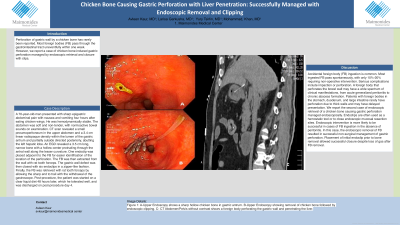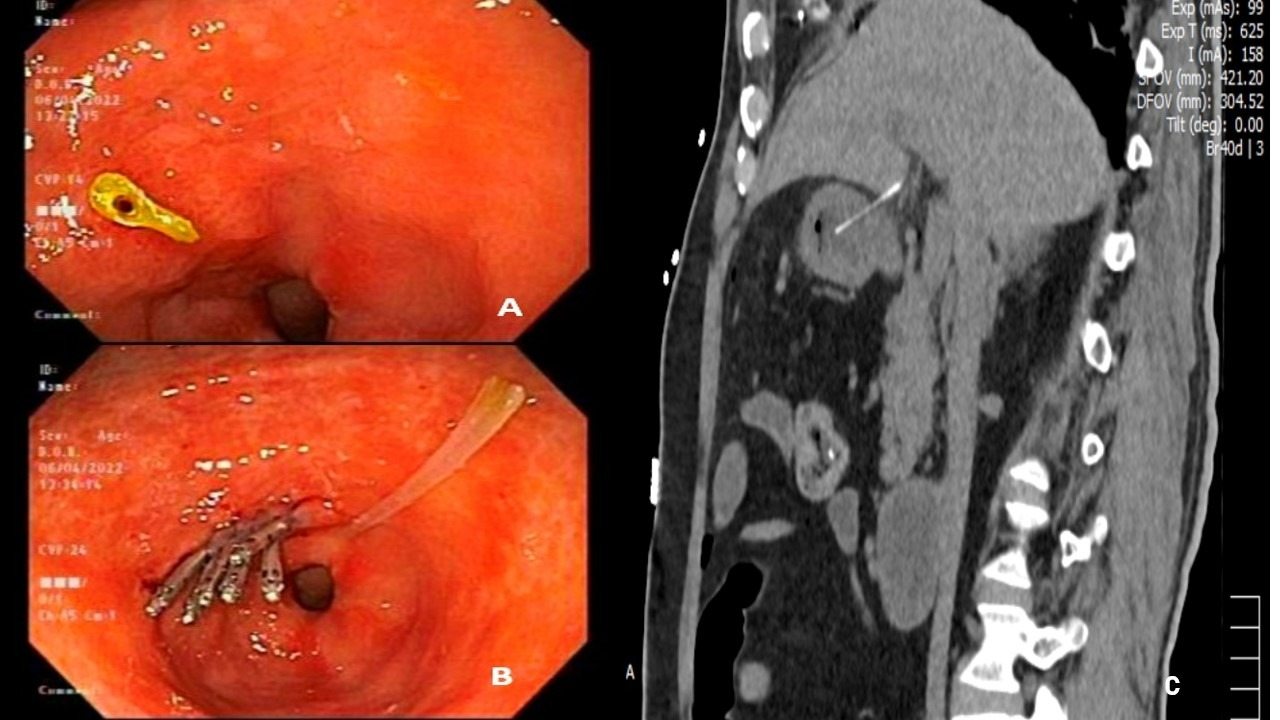Back


Poster Session A - Sunday Afternoon
Category: General Endoscopy
A0280 - Chicken Bone Causing Gastric Perforation With Liver Penetration: Successfully Managed With Endoscopic Removal and Clipping
Sunday, October 23, 2022
5:00 PM – 7:00 PM ET
Location: Crown Ballroom

Has Audio
- AK
Avleen Kaur, MD
Maimonides Health
Brooklyn, NY
Presenting Author(s)
Avleen Kaur, MD, Larisa Garkusha, MD, Yury Tsirlin, MD, Mohammad Kaur, MD
Maimonides Health, Brooklyn, NY
Introduction: Perforation of gastric wall by a chicken bone has rarely been reported. Most foreign bodies (FB) pass through the gastrointestinal tract uneventfully within one week. However, we report a case of chicken bone-induced gastric perforation managed by endoscopic retrieval and closure with clips.
Case Description/Methods: A 70-year-old-man presented with sharp epigastric abdominal pain with nausea and vomiting four hours after eating chicken wings. He was hemodynamically stable. The abdomen was soft and non-tender, with normoactive bowel sounds on examination. CT scan revealed a small pneumoperitoneum in the upper abdomen and a 3.4 cm linear radiopaque density within the lumen of the gastric antrum and partially outside directed posteriorly, abutting the left hepatic lobe. An EGD revealed a 3.5 cm long, narrow bone with a hollow center protruding through the antral wall along the lesser curvature. One endoclip was placed adjacent to the FB for easier identification of the location of the perforation. The FB was then extracted from the wall with rat tooth forceps. The gastric wall defect was then closed with six endoclips in a zipper-like fashion. Finally, the FB was retrieved with rat tooth forceps by allowing the sharp end to trail with the withdrawal of the gastroscope. Post-procedure, the patient was started on a clear liquid diet 48 hours later, which he tolerated well, and was discharged on post-procedure day 4.
Discussion: Accidental foreign body (FB) ingestion is common. Most ingested FB pass spontaneously, with only 10%-20% requiring non-operative intervention. Serious complications include impaction or perforation. A foreign body that perforates the bowel wall may have a wide spectrum of clinical manifestations, from acute generalized peritonitis to chronic abscess formation. Patients with foreign bodies in the stomach, duodenum, and large intestine rarely have perforation due to thick walls and may have delayed presentation. We report the second case of endoscopic retrieval of a chicken bone causing gastric perforation managed endoscopically. Endoclips are often used as a hemostatic tool or to close endoscopic mucosal resection sites. Endoscopic intervention is more likely to be successful in cases of FB ingestion in the absence of peritonitis. In this case, the endoscopic removal of FB resulted in successful non-surgical management of gastric perforation. Placement of initial endoclip prior to bone removal allowed successful closure despite loss of gas after FB removal.

Disclosures:
Avleen Kaur, MD, Larisa Garkusha, MD, Yury Tsirlin, MD, Mohammad Kaur, MD. A0280 - Chicken Bone Causing Gastric Perforation With Liver Penetration: Successfully Managed With Endoscopic Removal and Clipping, ACG 2022 Annual Scientific Meeting Abstracts. Charlotte, NC: American College of Gastroenterology.
Maimonides Health, Brooklyn, NY
Introduction: Perforation of gastric wall by a chicken bone has rarely been reported. Most foreign bodies (FB) pass through the gastrointestinal tract uneventfully within one week. However, we report a case of chicken bone-induced gastric perforation managed by endoscopic retrieval and closure with clips.
Case Description/Methods: A 70-year-old-man presented with sharp epigastric abdominal pain with nausea and vomiting four hours after eating chicken wings. He was hemodynamically stable. The abdomen was soft and non-tender, with normoactive bowel sounds on examination. CT scan revealed a small pneumoperitoneum in the upper abdomen and a 3.4 cm linear radiopaque density within the lumen of the gastric antrum and partially outside directed posteriorly, abutting the left hepatic lobe. An EGD revealed a 3.5 cm long, narrow bone with a hollow center protruding through the antral wall along the lesser curvature. One endoclip was placed adjacent to the FB for easier identification of the location of the perforation. The FB was then extracted from the wall with rat tooth forceps. The gastric wall defect was then closed with six endoclips in a zipper-like fashion. Finally, the FB was retrieved with rat tooth forceps by allowing the sharp end to trail with the withdrawal of the gastroscope. Post-procedure, the patient was started on a clear liquid diet 48 hours later, which he tolerated well, and was discharged on post-procedure day 4.
Discussion: Accidental foreign body (FB) ingestion is common. Most ingested FB pass spontaneously, with only 10%-20% requiring non-operative intervention. Serious complications include impaction or perforation. A foreign body that perforates the bowel wall may have a wide spectrum of clinical manifestations, from acute generalized peritonitis to chronic abscess formation. Patients with foreign bodies in the stomach, duodenum, and large intestine rarely have perforation due to thick walls and may have delayed presentation. We report the second case of endoscopic retrieval of a chicken bone causing gastric perforation managed endoscopically. Endoclips are often used as a hemostatic tool or to close endoscopic mucosal resection sites. Endoscopic intervention is more likely to be successful in cases of FB ingestion in the absence of peritonitis. In this case, the endoscopic removal of FB resulted in successful non-surgical management of gastric perforation. Placement of initial endoclip prior to bone removal allowed successful closure despite loss of gas after FB removal.

Figure: Figure 1: A-Upper Endoscopy shows a sharp hollow chicken bone in gastric antrum. B-Upper Endoscopy showing removal of chicken bone followed by endoscopic clipping. C- CT Abdomen/Pelvis without contrast shows a foreign body perforating the gastric wall and penetrating the liver.
Disclosures:
Avleen Kaur indicated no relevant financial relationships.
Larisa Garkusha indicated no relevant financial relationships.
Yury Tsirlin indicated no relevant financial relationships.
Mohammad Kaur indicated no relevant financial relationships.
Avleen Kaur, MD, Larisa Garkusha, MD, Yury Tsirlin, MD, Mohammad Kaur, MD. A0280 - Chicken Bone Causing Gastric Perforation With Liver Penetration: Successfully Managed With Endoscopic Removal and Clipping, ACG 2022 Annual Scientific Meeting Abstracts. Charlotte, NC: American College of Gastroenterology.
